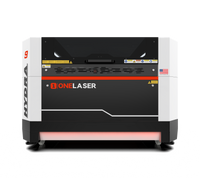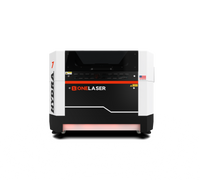In recent years, the world of crafting, personalization, and small-scale manufacturing has exploded. From engraved tumblers to wooden signs and acrylic décor, more creators are turning their homes into creative studios with the help of a home laser engraving machine.
But here’s the truth most people don’t realize: not all laser machines are safe or reliable enough for home use.
Many low-cost options circulating online may look similar on the surface, but they often hide poor wiring, unstable electrical systems, and subpar components that can pose real safety risks.
So, before you jump into buying one, ask yourself — are you really ready to have a laser machine at home?
Key Takeaway
This article will guide you through the electrical safety considerations, performance standards, and why the OneLaser Hydra Series stands out as the best home laser engraving machine for serious creators and small business owners.
1. The Hidden Problem with Most Home Laser Machines
If you’ve shopped around, you’ve likely seen hundreds of laser engravers claiming to be “home-safe” or “plug-and-play.” The unfortunate reality is that most machines on the market are built with inconsistent wiring and lower safety standards.
These budget systems often use thin wiring, ungrounded components, and low-grade electrical circuits — choices that might cut costs but compromise safety. Over time, this can lead to:
- Unstable voltage and power surges
- Breaker trips or flickering performance under load
- Overheating wires or even electrical fires
- Reduced lifespan of laser tubes and internal components
When you bring a laser engraving machine for home use, safety and reliability aren’t optional — they’re essential.
2. Why Electrical Safety Should Come First
Unlike small appliances like coffee makers or fans, laser engravers require stable, high-current power delivery. The laser tube, motion motors, and control boards all depend on consistent voltage to function correctly.
If the circuit can’t deliver enough power, you’ll experience drops in engraving quality, longer processing times, or unexpected shutdowns.
Even worse, a poorly wired system can overload your home’s electrical line — leading to wire heating, circuit fatigue, or fire hazards.

That’s why the Hydra Series by OneLaser was designed to meet or exceed U.S. electrical safety standards, offering true peace of mind for home creators and professionals alike.
3. Meet the Hydra Series: Built to U.S. Electrical Standards
The OneLaser Hydra Series isn’t a repackaged import — it’s a flagship system designed by U.S. engineers from the ground up.
Every component, from the wiring harnesses to the grounding systems, is selected to meet the highest American electrical safety codes (UL and NEMA standards).
Hydra’s internal layout is engineered to prevent electrical noise, overheating, and voltage drop — delivering stable, precise power even under long production cycles.
This engineering discipline ensures that the Hydra performs with industrial reliability while staying safe enough for your home workspace.
4. Why the Hydra Uses a NEMA 5-20P Plug — And Why That Matters
One common question users ask is:
“Why does the Hydra have a 20A plug instead of a regular 15A household plug?”
The answer lies in power capacity and safety design.
Most household outlets are rated for 15 amps and use thinner 14-gauge wires. However, high-performance machines like the Hydra require stronger and more stable electrical delivery — especially when running high-powered CO₂ lasers.
That’s why the Hydra uses a NEMA 5-20P plug, which features a distinct T-shaped neutral blade. This design prevents you from plugging the machine into an underpowered outlet, avoiding overheating and electrical stress.

Here’s why the 20A design matters:
- Lower voltage drop: 12-gauge copper wire minimizes resistance and ensures steady current flow.
- Thermal safety margin: Avoids overheating and protects components under heavy operation.
- Future-proofing: The Hydra supports multiple laser modules and potential upgrades without needing electrical redesigns.
5. Can You Use the Hydra on a Regular Home Outlet?
Yes — technically, the Hydra can run on standard 110–120V outlets. However, that doesn’t mean all outlets are created equal.
If you use a NEMA 5-20P to 5-15R adapter, you can plug it into a 15A outlet, but this should only be a temporary solution. Most homes use 15A breakers, and long-term use of a high-powered laser on such a circuit may cause:
- Wire heating
- Outlet degradation
- Breaker tripping
- Fire risk
For a professional and safe setup, install a 20A line using 12-gauge wiring and a dedicated breaker. This small investment — usually under $300 — ensures your home laser engraving machine runs smoothly and safely.
6. Premium Components Make the Hydra Worth It
Where many low-cost machines save on cheap power supplies or connectors, OneLaser invests in premium-grade materials and engineering.
Hydra’s internal architecture includes:
- Industrial-grade copper wiring
- Isolated power circuits for each component
- Overheat and voltage protection systems
- Advanced grounding for electrical stability
This attention to detail ensures superior reliability, minimal maintenance, and long-term performance stability.
While others may advertise low prices, Hydra delivers true value — designed to last years under constant operation without compromising safety.

7. Designed for Professionals, Ready for Home Use
Even though the Hydra is engineered for production-scale performance, it’s also ideal for advanced home creators or small business owners.
Each model offers industrial precision with home-friendly usability. You get:
- ≤0.01mm positioning accuracy for flawless results
- Up to 2000 DPI engraving for photorealistic detail
- True 3G acceleration (29,430 mm/s²) for faster production
- Built-in leveling gauge for consistent alignment
- QuickSwitch™ lenses for easy tool-free adjustment
In short, the Hydra combines professional power with home-level accessibility, making it the best laser engraving machine for home business users who demand safety, precision, and performance.

8. Hydra’s Safety Systems Protect Your Home and Family
When operating a laser engraving machine indoors, safety features are critical — and Hydra leads the way.
Key Hydra safety technologies include:
- Fully enclosed workspace: Prevents laser exposure.
- FumeGuard™ filtration system: Removes harmful fumes to keep your air clean.
- Temperature alerts & automatic shutoffs: Prevents overheating damage.
- WiFi connectivity: Lets you monitor your laser remotely for added peace of mind.
- No-lid, no-operation lockout: The laser will not run unless securely closed.
These features make the Hydra one of the safest laser engraving machines for home use, ideal for creators who share their workspace with family, children, or pets.
9. Long-Term Value: Reliability That Pays Off
Buying a laser engraver is an investment. Many entry-level machines fail after 6–12 months of continuous use due to poor electrical design and unstable components.
Hydra, on the other hand, is designed for 24/7 operation, built with U.S. R&D support, and backed by a 3-Year Limited Warranty.
By choosing higher-quality engineering, you gain:
- Consistent performance
- Lower maintenance costs
- Longer tube lifespan (up to 30,000 hours for RF lasers)
- Greater productivity — less downtime, more output
For creators running an Etsy shop or small production business, reliability directly translates to profit.

The Bottom Line
Owning a home laser engraving machine is exciting — but it also comes with responsibility.
If you’re ready to invest in quality, safety, and long-term reliability, the OneLaser Hydra Series is built to deliver industrial-level results in a home-friendly package.
While others cut corners with cheap wiring and minimal protection, Hydra machines are engineered to U.S. standards, using premium components that ensure stable power, top-tier performance, and user safety.
From wood and acrylic to coated metal and leather, Hydra lets you create with precision — safely, confidently, and professionally.
So before you buy just any laser, ask yourself:
👉 Are you ready for a machine that works as hard as you do?
If the answer is yes, the OneLaser Hydra is ready to take your creativity to the next level.
FAQs
Q: Is it worth buying a laser engraving machine?
Absolutely. A home laser engraving machine can transform your creativity into a business opportunity. Whether you make custom gifts, signage, or décor, a reliable laser like the OneLaser Hydra Series lets you produce professional-quality results safely from home. It’s a long-term investment that can quickly pay for itself through sales and creative freedom.
Q: How much does it cost to install a 20A outlet?
Installing a dedicated 20A outlet typically costs between $250 and $350, depending on your home’s wiring layout. This one-time upgrade ensures your laser machine receives stable power and protects your wiring from overheating. OneLaser recommends hiring a licensed electrician for safe installation.
Q: What’s the safest way to power a laser engraving machine at home?
The safest method is to use a dedicated 20A circuit with 12-gauge copper wiring and a NEMA 5-20R outlet. Avoid using low-rated extension cords or shared circuits. This setup provides consistent voltage and minimizes electrical risks, ensuring your laser engraving machine for home use operates reliably and safely.
Q: Is the Hydra suitable for beginners?
Yes! While the Hydra Series is built for professional-grade performance, its OneTouch+™ touchscreen controls, autofocus, and WiFi connectivity make it beginner-friendly. New users can start small — engraving cups, wood signs, or leather patches — and gradually grow into advanced projects as their skills develop.
Q: How do I choose a good laser engraver?
When shopping for the best home laser engraving machine, prioritize:
- Electrical safety and U.S. certifications
- Stable power and wiring quality
- Precision and engraving speed
- Manufacturer support and warranty
Machines like the OneLaser Hydra check all these boxes, offering industrial-grade reliability in a home-ready form.
Q: What is the lifespan of a laser engraver?
It depends on the tube type and build quality. CO₂ glass tubes typically last 5,000–10,000 hours, while RF metal tubes can exceed 30,000 hours of use. The Hydra Series is engineered with premium components, advanced cooling systems, and maintenance-friendly design — extending its operational life for years of consistent, high-quality production.

 Liquid error (sections/image-banner line 171): invalid url input
Liquid error (sections/image-banner line 171): invalid url input






